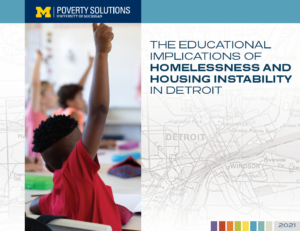36,000
Children in Michigan’s elementary, middle and high schools face homelessness
Poverty Solutions supports several projects that aim to promote a better understanding of the causes and consequences of homelessness and identify potential points of intervention.
36,000
Children in Michigan’s elementary, middle and high schools face homelessness

U-M’s Poverty Solutions collaborated with the Detroit Phoenix Center, a nonprofit that provides critical resources, wraparound support, and a safe, nurturing environment to youth experiencing homelessness and housing instability, to develop a series of communications workshops for its Summer Leadership Academy in the summer of 2022. Workshop topics included owning your narrative, defining your point of view, using data to support your point, and crafting advocacy statements. Youth put their communication skills into action in on-camera interviews on what giving back to the community looks like to them, and they wrote poems that explored their personal identities and how issues they care about impact their community. They also worked in groups to develop advocacy statements on the topics of their service-learning projects, which included mental health, basic needs, and criminal legal system reform.
 Homelessness has a lasting impact on educational outcomes for K-12 students. Across educational indicators, students experiencing homelessness struggle more than their housed peers, and these challenges persist even after stable housing is found. However, the data show exceptions to this overarching trend, which indicates schools’ responses can make a difference for students who have been homeless.
Homelessness has a lasting impact on educational outcomes for K-12 students. Across educational indicators, students experiencing homelessness struggle more than their housed peers, and these challenges persist even after stable housing is found. However, the data show exceptions to this overarching trend, which indicates schools’ responses can make a difference for students who have been homeless.
“The Educational Implications of Homelessness and Housing Instability in Detroit” databook, published in 2021, seeks to make new data on homelessness among K-12 students available to key stakeholders and policymakers in the City of Detroit in order to improve program planning and services. During its first year, 2019, this project helped uncover the under identification of Detroit students experiencing homelessness. As a result, Detroit CAM and Wayne Metro Community Action Agency partnered to ensure all families entering Detroit’s family shelters are connected to educational supports at their children’s schools. That referral system connected more than 1,100 children to educational supporters in its first year – more than three times the number of children in shelter identified as receiving supports in the 2017-18 school year.
This project is supported by the McGregor Fund and Skillman Foundation.
>>Section 1: Homelessness in Detroit and the challenge of under identification
>>Section 2: Unpacking the educational impact of homelessness in Detroit schools
>>Section 3: A snapshot of Detroit Public Schools Community District and all Detroit charter schools
>>Section 4: A statewide perspective
>>Section 5: Homelessness, the social safety net, and foster care
>>Section 6: Appendices (student homelessness data by Detroit city council district, Michigan intermediate school district, county, state House district, and state Senate district)
With support from SchoolHouse Connection, a national nonprofit working to overcome homelessness through education, Poverty Solutions is contributing to a national Education Leads Home: Data-to-Action Playbook designed to distill basic “how to” information for use by other state organizations who wish to replicate analyses and use them to promote data-driven best practices to support homeless children and youth. The playbook will feature Building Changes in Washington State and the Education Trust in New York as well as Poverty Solutions’ approach to “The Educational Implications of Homelessness and Housing Instability in Detroit” databook.
Stakeholders from the homelessness response and workforce systems in Detroit have been meeting with consultation from the Heartland Alliance to advance efforts to better serve people who are homeless in their efforts to obtain employment. In support of this work, Poverty Solutions is providing data matching and analysis of Detroit’s Homelessness Management Information System and Detroit at Work’s data to better understand the overlap of clients using these two systems, prior to the city’s efforts to improve cross-system coordination. This project is informed by communities around the country that have utilized a data match between the homeless service and workforce sectors to steward conversations on how these two systems can most effectively integrate their work.
In the 2019-20 school year, Michigan’s public schools identified 4,575 homeless youth living independent of parental support. These youth are homeless: living outside, in shelters, or bouncing from couch to couch. They are estranged from their parents, usually due to abuse, neglect, or parents’ struggles with addiction, mental health problems, or extreme poverty. Homeless youth experience multiple negative physical, mental, and behavioral health outcomes including roughly three times the rate of sexual assault and five times the rate of attempted suicide when compared to their housed peers.
Amidst these challenges, youth who are homeless in Michigan are very unlikely to be able to access medical care or emergency shelter. In Michigan, only 35% of homeless high school students had seen a primary care provider in the last 12 months, compared to 76% of youth who were not homeless. Likewise, while more than 4,000 homeless unaccompanied youth are identified by Michigan public schools annually, only around 700 are utilizing the state’s shelters for unaccompanied minors.
This project seeks to bring together key stakeholders across the state to raise awareness of the risk unaccompanied minors face and to identify opportunities to improve systems of support.

Director of Housing Stability Programs and Policy Initiatives
734-764-5435 jerbdown@umich.edu